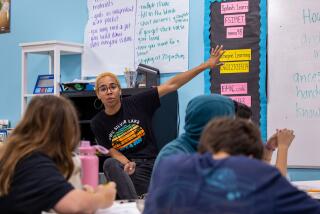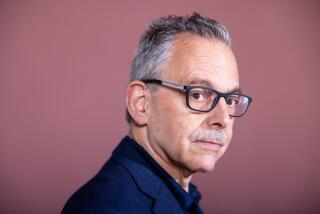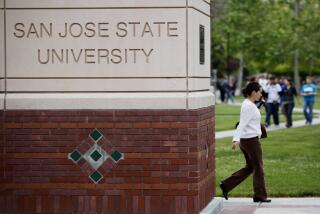Good Teaching--What Is It?
- Share via
In the movement to give good teaching more respect at American universities, a basic question looms: Just what is good teaching?
“Everybody seems to recognize what it is, but nobody is very good at saying what it is. It’s very hard to pin down,” explained Ellen Woods, an assistant dean at Stanford University’s School of Humanities and Sciences who helps manage teaching awards.
Mastery of the subject material, of course, is key, experts say. So are accessibility to students and an ability to engage young minds. But after that, much depends on the subject itself, the level of the student and the setting. After all, university teaching ranges from performing in a large lecture hall before 500 frightened freshmen to sharing a microscope with a very sophisticated doctoral candidate.
At the same time, faculty members at research institutions are expected to keep up their original scholarship. Balancing all of that is not easy, but it can be done, say three professors singled out for teaching honors by their campuses.
ALEX FILIPPENKO, UC Berkeley
At first glance, the introductory astronomy class seemed to be another grim reminder of mass education at UC Berkeley. Into the steeply sloped auditorium walked about 400 students--not an unusual number for an introductory course. But it is an unusual class.
Enter Prof. Alex Filippenko, wearing a cordless microphone and a shirt bearing a drawing of Galileo. As he begins to talk, the vast hall seems to shrink. Radiating energy like the supernovas he studies, Filippenko uses slides, jokes and props, waves his hands and jumps to make points. His activity is so intense, teaching assistants joke, that it is difficult to tell whose hands are moving faster--Filippenko’s or the two signers frantically translating for a deaf student in the front row.
He stretches a long chain of paper clips and rubber bands to show how the space between galaxies expands at ever-increasing rates. He blows up a balloon to help students visualize theories of the curvature of the universe. He sets off a slew of mousetraps to simulate the uncontrolled thermonuclear reactions on the sun. He bombards the auditorium with little balls to show how atoms shoot off photons.
“Especially in a big class, it’s certainly important to put on a good show, to attract the attention of people who generally, from 3 to 4 in the afternoon, a couple of hours after lunch, like to take a snooze in a room that tends to be stuffy. So you’ve got to be animated,” Filippenko, 34, explained. That’s particularly important because many students have “science and math phobias.”
Such theatricality, combined with mastery of the field, won Filippenko two major teaching awards at UC Berkeley last year.
“His style is very casual and the students respond to that because they are used to teachers being formal,” explained Young Paik, one of his teaching assistants. “He asks the students to call him Alex and I think it helps simply because they don’t fear him.” In answering questions, Filippenko often uses earthbound examples to explain astronomy principles, such as comparing the seeming merger of two separate stars to the blending of faraway car lights on a freeway, Paik said.
Dan Ladabaum, a junior majoring in biology, said the astronomy course was the best class he has had at Berkeley. “He’s so enthusiastic; he’s not talking in a monotone drone. When you hear someone who actually sounds excited talking about the stuff, you get interested too,” Ladabaum said.
One of Filippenko’s tricks is to prepare a volume of all the slide materials and formulas he uses in lectures. He sells photocopies of it to students at cost as an auxiliary text. That way, he hopes, they will concentrate on listening in class, instead of frantically scribbling or looking at their neighbors’ notebooks.
Another strategy involves his 30 astronomy-themed T-shirts, which have become a draw for students. “One might think it seems a silly reason to come to class--to see what I’m wearing that day,” Filippenko said. “But if they are on the borderline, on the seesaw, of skipping class, this might make them come. And if they are intrigued, they might stick around attentively to see why what’s on the shirt is relevant.”
JOHN RICKFORD, Stanford
The introductory linguistics class assembled in a tiny classroom at the edge of Stanford’s central sandstone quadrangle. The topic of the day was how language changes over time and among different population groups. With little introduction, Prof. John Rickford divided the 24 students into “buzz groups” of three and told them to come up with examples of outdated and new slang.
“It’s amazing how, one after another, the students will come up with the points you wanted to make. You can then reinforce it and elaborate on it,” Rickford told a visitor. “I think it tends to stick, it tends to be more interesting to them than if you just said these are the six points.”
Sure enough, after 10 minutes of brainstorming, students produced an array of examples: the overuse of like (as in “like, wow”), the disappearance of goodness gracious, the use of goes in place of said, the deaths of whom and shall, the increased acceptance of profanity in cultured company. The teacher, obviously pleased, commented on each example and encouraged more discussion.
Rickford then related their examples to methodical studies tracing language changes on Martha’s Vineyard, as vacationers on the Massachusetts island came to outnumber the Indian natives and English and Portuguese settlers. He handed out photocopies of charts from his own research on Jamaican Creole and how a speaker can gradually switch to standard English.
One of the first winners of the new Bing awards for excellent teaching at the Northern California school, Rickford, 43, is known in academic circles for his investigations of Caribbean dialects. So he does not advocate research cutbacks. “There is a limit to the quality of the instruction you can provide if you are not yourself on the cutting edge,” said the Guyana-born scholar.
Still, he added, the craft of teaching receives surprisingly little attention at America’s best universities. A professor can be given lifetime tenure by being “an excellent researcher and a so-so teacher. But you can almost never get tenure being an excellent teacher and a so-so researcher--at least not at Stanford, or presumably Yale or Harvard,” said Rickford, a stocky man with a salt-and-pepper beard.
Rickford plans to use some of his Bing funds, which total $10,000 annually for three years, to bring seminars about teaching to Stanford from the University of London. In Guyana, he was deeply influenced by the London technique of using constant interaction with students to supplement the formal lecture.
For example, during a fall class, he had half the students listen to the other half discuss issues of syntax and delivery; the listeners then reported on the syntax, delivery, pauses and interruptions of the speakers. The sides then switched tasks.
To make a more topical class, he recently arranged a debate over the English-only movement. He has played tapes of the Hopi Indian language and invited students to guess which words were articles and pronouns.
“I’ve never had a class where the teacher is so interested in what everyone has to say,” said sophomore Nicole Chandler.
Adding to his popularity, Rickford is a dormitory adviser. He lives and dines among students and is accustomed to serving as father figure and mediator on roommate problems and financial woes.
“Students respond to somebody who shows a commitment to them,” said Stanford education professor Lee Shulman, a nationally recognized expert on teacher evaluation.
EUNICE HOWE, USC
It was a sunny morning at USC, with bicyclists and skateboarders cruising by. But inside the darkened classroom of art history professor Eunice Howe, it was 15th Century Italy, with Howe the tour guide for 70 students in “Introduction to Western Art.”
Images of Medici palaces and Botticelli paintings flashed onto large screens as Howe, armed with a laser light pointer, stressed details, themes and philosophy. Not purely aesthetic appreciation, her approach was to get students to think about the social and historical forces that shape art.
Why create gold and bejeweled sculptures to be salt and pepper holders? Because spices were so rare and valuable at the time. Why were robes painted over the nudes in Michelangelo’s frescoes? Because of prudish fundamentalism that swept the Roman Catholic hierarchy. Why did Florentine banker princes favor sober architecture based on classical models? To project the image of solidity and longevity.
In Howe’s classroom, there was no flashy showmanship. Just a very dependable and informed voice in a darkened auditorium, flashing wry humor by sneaking a slide of an American turkey dinner into a pre-Thanksgiving lecture on Michelangelo. For lectures that students praise as clear and authoritative, her accessibility and sympathetic mentoring, Howe won a $5,000 prize for good teaching at USC in 1988.
“I think the secret of effective teaching is being genuinely committed to your subject and enthused with your subject. And fortunately, I still am,” Howe, 45, said after a recent class. “If I come to the point that I’m not interested in Renaissance art history any more, I hope I either can remedy that or have the guts to find something else to do, something other than teaching.”
The award was surprising, she said, because “no one ever told me before I had done a good job (teaching) and no one had ever told me I had done a poor job.” She gained tenure in 1985 mainly for her research on Roman art and architecture, work she continues with writings for journals and lectures at scholarly conferences. Her lectures are peppered with personal asides from her many visits to Italy, such as telling students how to gain entrance to Vatican apartments rarely seen by the public.
In Howe’s class “you get an overall sense of what’s going on, not only in the art world but also in history of the area where it was produced and the politics at the time that led to its creation,” said senior Loren Weiner. “I really appreciate that.”
Weiner recalled running into the professor after another scholar’s weekend lecture at the Los Angeles County Museum of Art. Howe escorted Weiner through some galleries, giving her a personal tour of some Renaissance paintings. “She is really willing to spend extra time talking to you,” Weiner said.
Recently, junior Emily Palmer discussed a term paper with Howe. What she expected to be a 15-minute visit stretched into an hour. “She is always available,” Palmer said. “If you make an appointment, she will be there, which is not true of every other professor. Some don’t show up or are late. They don’t value students’ time, which professor Howe does.”
Howe welcomes the movement to emphasize teaching more: “I just hope it’s not in the form of lip service, which is, I think, the stage it is in right now. I think we are very early in that movement and there are . . . people who are unwilling to see the change and who find it is a threatening thing.”







